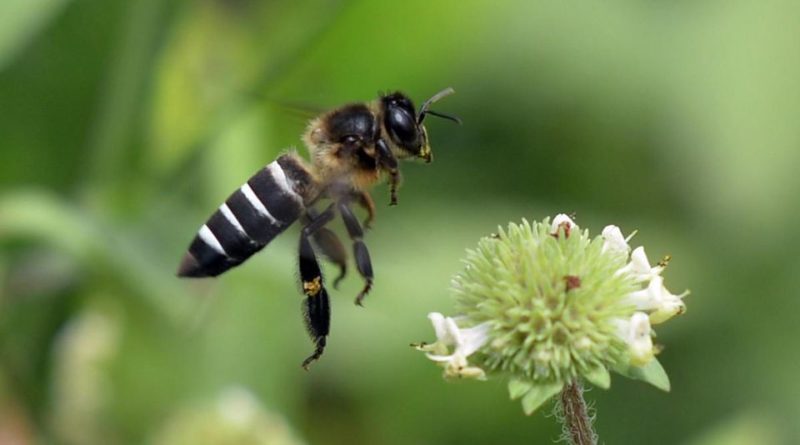SCI-TECH: How And Why Honey Bees Make The Ultimate Sacrifice When They Sting You
Why do honey bees die after they use their sting? originally appeared on Quora: The best answer to any question.
Answer by Matan Shelomi, Entomologist, Organismic Biologist, and Physiologist, on Quora:
.
.
.

There are four different ways of answering a “why” question in science [See Tinbergen’s four questions], and the other answers [in the original Quora thread] all hit on the different answers. So let’s combine everyone’s work:
Mechanistic answer: the honey bee worker’s stinger is barbed, and sticks in human skin. It doesn’t stick in all animals, though; a honey bee could sting a large insect, for example, and pull out her stinger safely. But for humans and other mammals with thick skin, the stinger gets stuck. When the bee tries to escape after stinging, she will inevitably break off her rear end and possibly disembowel herself and die.
.

Adaptive answer: the stinger is a hollow needle, but attached to it is a venom sack. When a bee stings, she injects venom through the needle. This venom is a nasty cocktail of poisons: chemicals to break down the cell membrane and cause pain, anti-inflammatories to stop blood flow that would otherwise clear out the toxins, histamines that give you the allergic reaction symptoms, and even pheromones that signal to any bees in the vicinity, “We are at war! Come, sister, and sting here too!” The sack is attached to the stinger, so when a bee dies after stinging, her venom sack is often left behind, still pumping poison into your skin. You are stung once, but get multiple doses, so it’s not a total tragedy for the bee.
.

Ontogenetic answer: did you notice I was only using female pronouns for the bees? That’s intentional, because only female bees can sting; the stinger is a modified ovipositor, or egg-laying tool. Worker bees seem to be born knowing what to do, and sting instinctively. I doubt they know their stinging will be fatal. All that matters is to get rid of whatever is attacking the colony, and stinging works. Since workers do not reproduce on their own, they are giving up their own lives so the queen and any new reproductives can survive to lay eggs in the future. Queen bees can sting too, but their stinger is not barbed and they can actually sting you multiple times without dying. They are not likely to sting the average person, since they rarely leave the hive and usually just sting rival queens coming to usurp the throne (ideally before they have finished their pupation…”Game of Thrones” has nothing on bee politics).
.

Phylogenetic answer: the gender is important for another reason: female bees are more closely related to their sisters than to their own children. That’s how such altruism evolved: a bee’s genes survive better in her sisters than her kids. This works because bees are “haplodiploid.” What that means is that females have two copies of every chromosome, but males only one. Males are produced by unfertilized eggs. You may have learned that humans have 23 pairs of chromosomes (46 total), and one pair are the sex chromosomes: XX for women, XY for men. A female bee will have 16 pairs of chromosomes (32 total), but the male only one copy (16 total). The female sex chromosomes are XX, but the male is just X.
Here’s where it gets a bit mathematical: a queen’s eggs, like a human’s egg cell, will each contain 50% of her genome (one copy of each chromosome). The queen is thus 50% genetically related to her babies. However, because the male has only one set of chromosomes, his sperm cells will each be 100% of his genome, unlike humans where sperm cells also are 50% of the father’s genome. How related are you to your siblings? 50% of your DNA came from mom, and represents 50% of her DNA. The same for dad. The chance that your sibling got the same DNA from each parent as you did is (50%*50%)+(50%*50%)=0.25+0.25=50%. You are 50% related to your sibling. What about worker bees? 50% of her DNA came from the queen, which represents 50% of her DNA. 50% of her DNA came from the drone, but that represents 100% of his DNA, because he only has one set of chromosomes to give. (50%*50%)+(50%*100%)=0.25+0.5=75%. Worker bees are 75% genetically identical to their sisters, but would only be 50% identical to their children. Thus, it makes evolutionary sense for a worker to forgo reproduction, and even sacrifice her own life, if it helps her sisters. This is called Kin selection.
While all bees and wasps are haplodiploid, the honey bee is one of the few, if not only, bees with a suicidal sting! Bumble bees and yellow jacket wasps have mostly smooth stingers and can attack repeatedly, and European hornets don’t even bother stinging. They are big enough to bite with their jaws. So why did honey bees evolve the barbs? They also evolved the most complex society out of the other wasps, so kin selection has clearly done a lot to these bees, but recall what I said earlier: the bee stinger only rips off in mammals, and when it does the venom sack keeps pumping. Because honey bees store lots of honey, they need to worry about mammals like bears and rodents and honey badgers who want to steal their honey. These animals would be a lot less interested in robbing the rotten caterpillars from a wasp nest, but a beehive with sweet honey and protein-rich larvae? A feast! So the honey bee evolved specifically anti-mammal defenses, including a stinger that keeps on injecting poison even after the bee has died. So their need to fight mammals gave the suicide-stinger an evolutionary advantage, while their haplodiploidy reduced the disadvantage of death by upping the advantage of saving one’s sister.
.

Summary: The bees die because the stinger is barbed and gets stuck, but it can keep pumping venom which makes it a great anti-mammal defense, and the bees don’t mind because their stinging is instinctive and does not harm their evolutionary fitness because kin selection means honey bees are better off saving their sisters than themselves.
That’s the science…but would you like some religion too? I’m gonna go out of character and give a wrong, but cute, answer:
There is an Aesop fable, “Jupiter and the Bee,” where the ancient Greek storyteller explains the origin of bee stings:
A bee from Mount Hymettus, the queen of the hive, ascended to Olympus to present Jupiter some honey fresh from her combs. Jupiter, delighted with the offering of honey, promised to give whatever she should ask. She therefore besought him, saying, “Give me, I pray thee, a sting, that if any mortal shall approach to take my honey, I may kill him.” Jupiter was much displeased, for he loved the race of man, but could not refuse the request because of his promise. He thus answered the Bee: “You shall have your request, but it will be at the peril of your own life. For if you use your sting, it shall remain in the wound you make, and then you will die from the loss of it.”
The moral of the story is that evil wishes will come back to harm you.
And there you go. A story fit for a Louisiana “science” class!
This question originally appeared on Quora. Ask a question, get a great answer. Learn from experts and access insider knowledge. You can follow Quora on Twitter, Facebook, and Google+. More questions:
- Honey Bees: What would happen if you put a bunch of food/honey in an ant hill or bee hive? Would they stop working?
- Evolutionary Biology: What are some interesting ways animals avoid predators?
- Science: How much truth is there in the popular belief that “natural” things are good?
.












